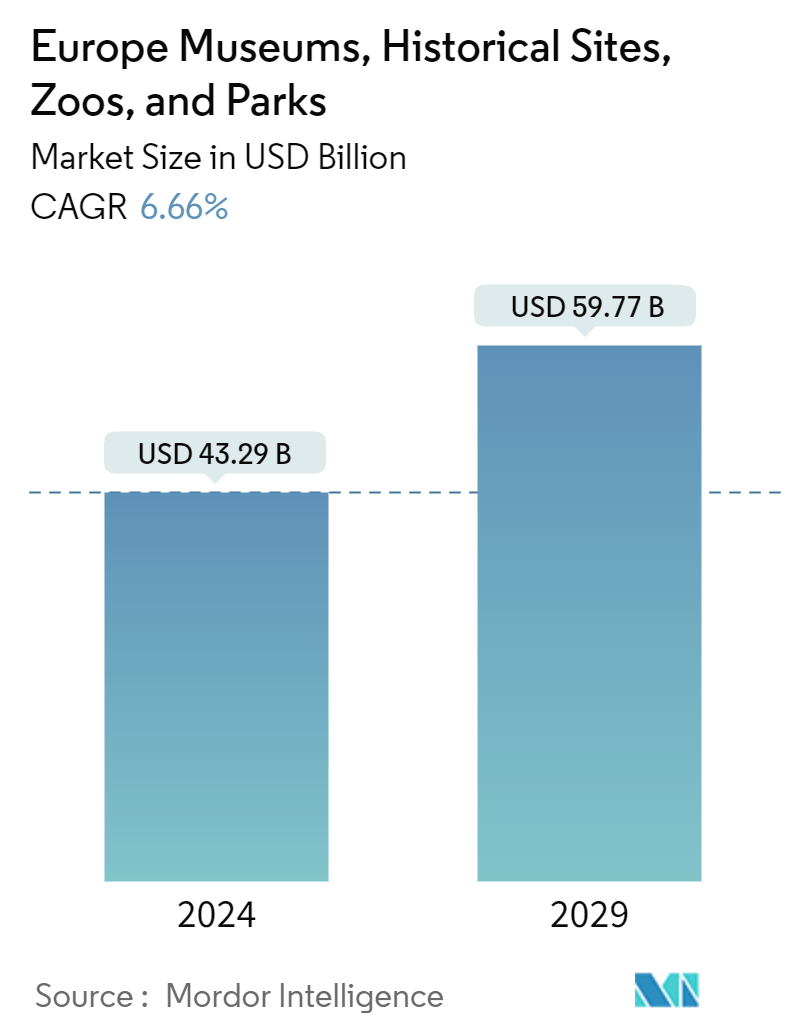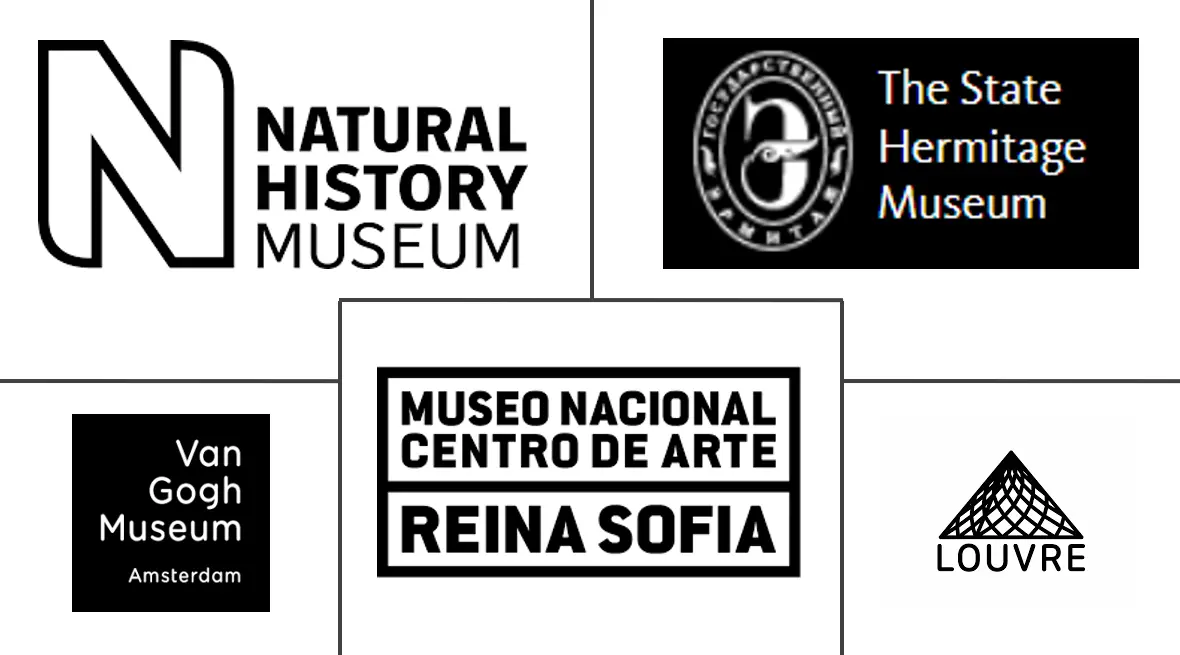Market Size of Europe Museums, Historical Sites, Zoos, And Parks

| Study Period | 2020 - 2029 |
| Base Year For Estimation | 2023 |
| Market Size (2024) | USD 43.29 Billion |
| Market Size (2029) | USD 59.77 Billion |
| CAGR (2024 - 2029) | 6.66 % |
| Market Concentration | Medium |
Major Players
*Disclaimer: Major Players sorted in no particular order |
Europe Museums, Historical Sites, Zoos, And Parks Market Analysis
The Europe Museums, Historical Sites, Zoos, And Parks Market size is estimated at USD 43.29 billion in 2024, and is expected to reach USD 59.77 billion by 2029, growing at a CAGR of 6.66% during the forecast period (2024-2029).
The market is set for significant expansion, fuelled by institutions' integration of digital innovations to stay pertinent in the digital era. This entails facilitating virtual exploration of exhibits and delivering educational experiences to individuals, including students who may be unable to venture outside their classrooms.
A major driver of market growth is the relaxation of governmental restrictions worldwide, leading to an uptick in visitor numbers to museums, historical sites, zoos, and parks. Additionally, the adoption of digital technologies enhances the accessibility of these attractions, amplifying their reach beyond physical boundaries and catering to a broader audience base. Furthermore, the surge in global travel activity indirectly contributes to market expansion, as tourists seek cultural enrichment and wildlife experiences.
Furthermore, zoos are adapting to evolving societal attitudes and ethical concerns regarding animal welfare. Efforts are underway to reshape visitor experiences by prioritizing the well-being of animals. Various zoos are implementing innovative concepts, such as the Philadelphia Zoo's zoo360 initiative, which includes features like the Big Cat crossing. These changes align with the advocacy for animal rights and contribute to the sustainability and relevance of zoos in the modern era.
In conclusion, the market is witnessing dynamic growth fuelled by factors such as the adoption of digitalization, relaxation of restrictions, and evolving approaches to animal welfare. By considering these trends and implementing innovative strategies, institutions can ensure their continued relevance and appeal to visitors in the years ahead.
Europe Museums, Historical Sites, Zoos, And Parks Industry Segmentation
A museum is where many one-of-a-kind and priceless goods, like historical artifacts or pieces of art, are maintained, examined, and presented to the general public. An official location where artifacts from social, political, or military history have been preserved for cultural heritage purposes is a historic site or heritage site. A zoo is a collection of wild animals kept in a park or garden for research, conservation, or public display. In contrast, a national park is a government-designated area for environmental preservation. Museums, Historical Sites, Zoos, And Parks report will cover insights into the world's Museums, Historical Sites, Zoos, And Parks sector, drivers, and market restraints. The report will also cover information on some of the major players active in the region.
Europe museums, historical sites, zoos, and parks are segmented by type, by revenue source, by geography. By type, the market is sub-segmented into museums, historical sites, zoos and botanical gardens, nature parks, and other similar institutions. By revenue source, the market is sub-segmented into tickets, food and beverages, and other revenue sources, and by geography market is segmented into France, Germany, United Kingdom, Italy, and Rest of Europe. The market sizes and forecasts for Europe museums, historical sites, zoos, and parks are provided in value (USD) for all the above segments.
| By Type | |
| Museums | |
| Historical Sites | |
| Zoos And Botanical Gardens | |
| Nature Parks | |
| Other Similar Institutions |
| By Revenue Source | |
| Tickets | |
| Food And Beverages | |
| Other Revenue Souces |
| By Country | |
| France | |
| Germany | |
| United Kingdom | |
| Italy | |
| Rest of Europe |
Europe Museums, Historical Sites, Zoos, And Parks Size Summary
The Europe Museums, Historical Sites, Zoos, and Parks market is poised for substantial growth, driven by the integration of digital innovations and the relaxation of governmental restrictions. Institutions are increasingly adopting digital technologies to enhance visitor experiences, offering virtual explorations and educational content that extend beyond physical locations. This trend is further bolstered by the resurgence in global travel, as tourists seek cultural and wildlife experiences. Zoos are also evolving to address societal concerns about animal welfare, implementing initiatives that prioritize animal well-being and align with modern ethical standards. These developments are crucial for maintaining the relevance and sustainability of these attractions in a rapidly changing landscape.
Europe's appeal as a top tourist destination significantly contributes to the market's expansion, with museums playing a central role in attracting visitors. To enhance engagement, museums are utilizing pre-recorded audio guides and augmented reality technologies, providing interactive and immersive experiences. These innovations not only increase visitor interaction but also serve as additional revenue streams. The competitive market landscape features prominent players such as the Louvre, State Hermitage, and British Museum, among others. As institutions continue to embrace digital advancements and innovative strategies, they are well-positioned to maintain their appeal and competitiveness in the coming years.
Europe Museums, Historical Sites, Zoos, And Parks Market Size - Table of Contents
-
1. MARKET DYNAMICS AND INSIGHTS
-
1.1 Market Overview
-
1.2 Market Drivers
-
1.2.1 Rise in the Number of Visitors to Museums is Driving the Market
-
1.2.2 Digitalization is Driving the Market
-
-
1.3 Market Restraints
-
1.3.1 Maintenance and Preservation Costs
-
1.3.2 Changing Visitor Preferences
-
-
1.4 Opportunities
-
1.4.1 Digital Engagement and Virtual Experiences
-
1.4.2 Cultural Heritage Preservation
-
-
1.5 Value Chain Analysis
-
1.6 Industry Attractiveness: Porter's Five Forces Analysis
-
1.6.1 Threat of New Entrants
-
1.6.2 Bargaining Power of Buyers
-
1.6.3 Bargaining Power of Suppliers
-
1.6.4 Threat of Substitutes
-
1.6.5 Intensity of Competitive Rivalry
-
-
1.7 Insights into Technological Advancements in the Industry
-
1.8 Impact of COVID-19 on the Market
-
-
2. MARKET SEGMENTATION
-
2.1 By Type
-
2.1.1 Museums
-
2.1.2 Historical Sites
-
2.1.3 Zoos And Botanical Gardens
-
2.1.4 Nature Parks
-
2.1.5 Other Similar Institutions
-
-
2.2 By Revenue Source
-
2.2.1 Tickets
-
2.2.2 Food And Beverages
-
2.2.3 Other Revenue Souces
-
-
2.3 By Country
-
2.3.1 France
-
2.3.2 Germany
-
2.3.3 United Kingdom
-
2.3.4 Italy
-
2.3.5 Rest of Europe
-
-
Europe Museums, Historical Sites, Zoos, And Parks Market Size FAQs
How big is the Europe Museums, Historical Sites, Zoos, And Parks Market?
The Europe Museums, Historical Sites, Zoos, And Parks Market size is expected to reach USD 43.29 billion in 2024 and grow at a CAGR of 6.66% to reach USD 59.77 billion by 2029.
What is the current Europe Museums, Historical Sites, Zoos, And Parks Market size?
In 2024, the Europe Museums, Historical Sites, Zoos, And Parks Market size is expected to reach USD 43.29 billion.

